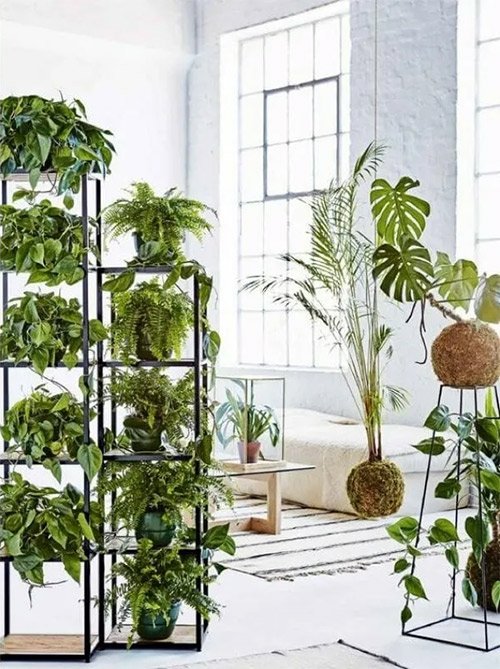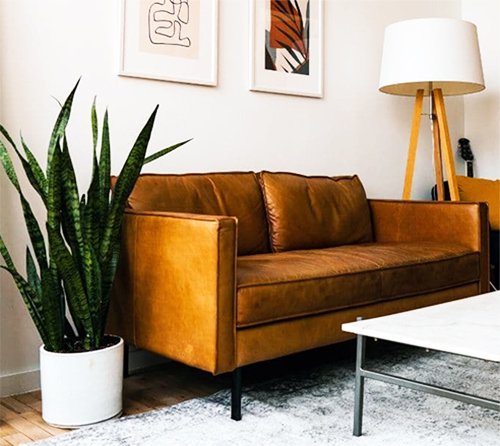Incorporating plants into your living room decor is a fantastic way to breathe new life into your space. Not only do plants add visual interest and natural beauty, but they also offer numerous benefits for your health and well-being. From improving air quality to reducing stress, plants can transform your living room into a more inviting, relaxing, and vibrant environment.
This guide will walk you through the process of refreshing your living room with plants, covering everything from selecting the right plants to caring for them and incorporating them into your existing decor.

@decorilla
Assessing Your Living Room
Before you start adding plants to your living room, it’s essential to assess your space. Consider the following factors:
- Available space: Look for potential plant placement areas, keeping in mind traffic flow and functionality.
- Light conditions: Identify natural light sources and areas with low light.
- Humidity and temperature: Different plants thrive in different conditions, so understanding your room’s climate is crucial.
- Existing decor: Consider your current color scheme and style to ensure your plants complement your space.

@decorilla
Choosing the Right Plants for Your Living Room
Selecting the right plants is crucial for success. Here are some options based on different light conditions and other factors:
- Low-light plants:
- Snake plants (Sansevieria)
- ZZ plants (Zamioculcas zamiifolia)
- Pothos (Epipremnum aureum)
- Medium to bright light plants:
- Fiddle leaf fig (Ficus lyrata)
- Monstera deliciosa
- Rubber plant (Ficus elastica)
- Air-purifying plants:
- Spider plant (Chlorophytum comosum)
- Peace lily (Spathiphyllum)
- Dracaena varieties
- Pet-friendly options:
- Boston fern (Nephrolepis exaltata)
- Parlor palm (Chamaedorea elegans)
- Ponytail palm (Beaucarnea recurvata)
Choose a mix of plants that suit your space’s conditions and your personal preferences.

@decorilla
Plant Placement Strategies
Effective plant placement can dramatically enhance your living room’s appeal. Consider these strategies:
- Create a focal point: Use a large, statement plant in an empty corner or as a centerpiece.
- Layer plants: Combine different heights and textures to create depth and interest.
- Utilize vertical space: Hang plants from the ceiling or install wall-mounted planters.
- Incorporate plants into existing furniture: Add small plants to shelves, bookcases, or tabletops.
Remember to maintain balance and avoid overcrowding. The goal is to enhance your space, not overwhelm it.

@decorilla
Choosing Plant Containers and Stands
The right containers can elevate your plants from mere greenery to decor statements. Consider these factors:
- Style: Choose containers that match or complement your decor style, whether it’s modern, bohemian, or traditional.
- Size and material: Ensure the container is appropriate for the plant’s size and growth habits. Materials like ceramic, metal, or natural fibers can add texture and interest.
- Plant stands: Use stands to create height variation and add visual interest.
Don’t be afraid to mix and match containers for an eclectic look, but maintain some cohesion through color, material, or style.

@decorilla
Creating Plant Vignettes and Groupings
Grouping plants can create stunning visual displays. Keep these principles in mind:
- Use odd numbers: Groups of three or five plants often look more natural and appealing.
- Vary heights and textures: Combine tall, medium, and trailing plants for a dynamic look.
- Create themed groupings: For example, a tropical corner or a desert-inspired succulent display.
- Incorporate decorative objects: Mix in books, artwork, or natural elements like rocks or driftwood to create interesting vignettes.

@decorilla
Caring for Your Living Room Plants
Proper care is essential to keep your plants thriving:
- Watering: Learn the specific needs of each plant. Generally, it’s better to underwater than overwater.
- Light management: Rotate plants regularly for even growth, and use sheer curtains to filter harsh direct sunlight if needed.
- Fertilizing and pruning: Most indoor plants benefit from fertilization during the growing season. Prune regularly to maintain shape and encourage healthy growth.
- Pest prevention: Inspect your plants regularly and treat any issues promptly, preferably with natural methods.

@jayscotts
DIY Plant Projects for Living Room Decor
Get creative with these DIY plant projects:
- Living wall: Create a stunning vertical garden using a variety of plants.
- Terrarium: Build a miniature ecosystem in a glass container.
- Macramé plant hangers: Craft stylish hangers for your trailing plants.
These projects can add a personal touch to your plant decor and serve as engaging weekend activities.

Seasonal Plant Refresh Ideas
Keep your living room looking fresh year-round with these seasonal ideas:
- Spring: Introduce flowering plants and bright, new foliage.
- Summer: Add lush, large-leafed plants for a tropical vibe.
- Fall: Incorporate plants with warm-toned foliage and add texture with dried arrangements.
- Winter: Focus on evergreen plants and create holiday-themed displays.
Rotating your plants seasonally can keep your space feeling dynamic and in tune with the changing year.

@modernize
Incorporating Plants into Different Living Room Styles
Plants can enhance any decor style:
- Minimalist and modern: Choose sleek, architectural plants and clean-lined containers.
- Bohemian and eclectic: Mix various plant types and use unique, handcrafted planters.
- Scandinavian-inspired: Focus on clean, simple plant choices and incorporate natural wood elements.
- Traditional and classic: Opt for elegant, timeless plants in ornate or vintage-style containers.
The key is to choose plants and containers that complement your existing style while adding a fresh, natural element.

@interiorcompany
Balancing Plants with Other Living Room Elements
Integrate your plants seamlessly with these tips:
- Coordinate with furniture: Use plants to complement seating arrangements and soften hard edges.
- Integrate with color schemes: Choose plants that enhance your existing colors or add new accents.
- Harmonize textures: Pair plant textures with existing fabrics and finishes for a cohesive look.

@decormatters
Maintaining a Cohesive Look
To keep your plant-filled living room looking intentional and stylish:
- Create visual flow by repeating plant types or container styles throughout the room.
- Avoid overcrowding; remember that negative space is important in design.
- Regularly assess your plant arrangements and make adjustments as needed.

@interiorcompany
The Impact of Plants on Well-being in the Living Room
Beyond aesthetics, plants offer numerous benefits:
- Improved air quality: Many plants naturally purify air and increase humidity.
- Psychological benefits: Plants can reduce stress, enhance mood, and boost creativity.
- Connection with nature: Plants satisfy our innate need to connect with natural elements, even indoors.

@interiorcompany
Conclusion
Refreshing your living room with plants is a rewarding process that can dramatically transform your space. By carefully selecting, placing, and caring for your plants, you can create a living room that’s not only beautiful but also healthier and more enjoyable to live in.
